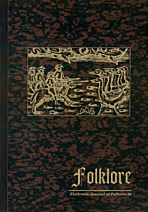Dwarfs and Cranes. Baltic-Finnish Mythologies in Eurasian and American Perspective (70 years after Yrjö Toivonen)
Dwarfs and Cranes. Baltic-Finnish Mythologies in Eurasian and American Perspective (70 years after Yrjö Toivonen)
Author(s): Yuri E. BerezkinSubject(s): Customs / Folklore
Published by: Eesti Kirjandusmuuseum
Keywords: peopling of the New World; comparative mythology; Eurasian and Amerindian cosmologies; Yrjö Toivonen
Summary/Abstract: Tales about the struggle between dwarfs and birds are widespreadacross Eurasia and the Americas. About half of them were known to Toivonen(1937), but a large part of the American and some of the Asian materials remained beyond the scope of his research. The southernmost Eurasian version is from Nagaland. The closest parallels are between Ancient Greek, Fennoscandian, Chinese, Lower Amur and North-American tales. In eastern South America (Upper Xingu) dwarfs at the edge of the earth are replaced with the souls of the dead in the sky. Among 35,000 texts included into the author’s electronic database, about 100 Eurasian, North- and South-American cases are relevant to the theme. Several motifs, partially overlapped and variously combined, reflect a unique set of cosmological ideas. Creatures different from (normal) human beings who live in a distant land fight with non-human enemies (birds, crabs, hares, etc.); man readily helps these creatures because for him their enemies are not dangerous; birds attack man who comes to the other world; migratory birds fly from our world to another one; at the boundary, sky is constantly moving in respect to earth or the opening leading to other world is narrow, many birds perish; there is a person at the passage to other world who feeds on birds; mistress of birds lives on the other side of the moving obstacle. The spread of this complex across all the New World allows us to date the corresponding ideas to the time of the initial peopling of the Americas (about 14,000 BP). The complex had taken its final shape in Northern Eurasia. The existence of South American versions and the absence of parallels in Australia and most of South and Southeast Asia (African materials are still not processed) is evidence in favor of historic connections between all known cases. Ecological factors are not sufficient to explain their independent emergence.
Journal: Folklore: Electronic Journal of Folklore
- Issue Year: 2007
- Issue No: 36
- Page Range: 67-88
- Page Count: 22
- Language: English

